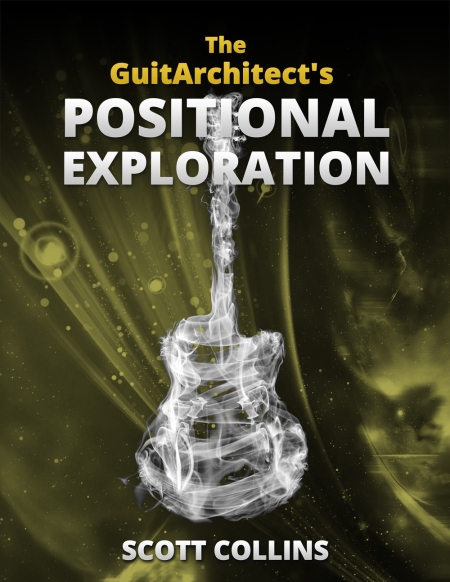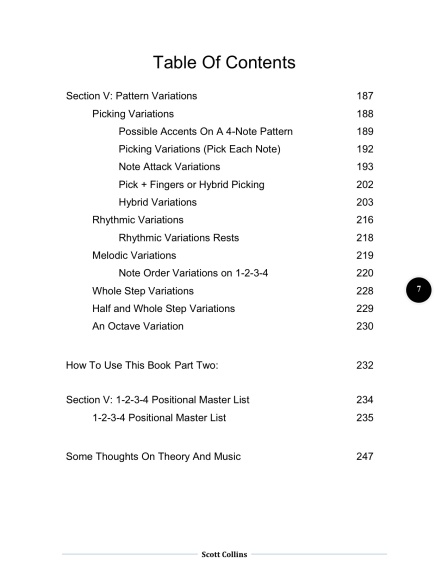The GuitArchitect’s Positional Exploration
.
If you are looking for new ways to explore the fretboard, or new sounds to investigate – the books in The GuitArchitect’s Guide To…. series are for you!!
The GuitArchitect’s Positional Exploration
(254 pages)
.
In The GuitArchitect’s Positional Exploration, I’ve taken an introductory guitar exercise and turned it on its head to reveal deep possibilities that exist not only in positional visualization, but in technical awareness as well.
.
This book shows how to take a simple idea and creatively develop and modify it through melodic, harmonic and rhythmic variations that can be applied to your own music as well.
.
The GuitArchitect’s Positional Exploration Guide:
This book takes the initial 1-2-3-4 exercise and then adapts it to all other string-set-combinations in position. But it also does some other important things for the reader:
- In addition to documenting each example in the 8th position, it provides chordal analysis and a detailed series of charts for determining multiple harmonic interpretation of the notes involved.
- From a technical standpoint, the book explores every possible variation of note attack that can be executed. This could lead to entirely new technical approaches for the reader.
- From a compositional/improvisational standpoint, the book covers a series of ways to manipulate the patterns, rhythmically and melodically in a systematic way to develop ideas fully.
I have a lesson on Guitar-Muse that uses material directly from the book. If you want to get a sense of the content you can see it here.
.
I’ve included jpegs of some of the pages from the Positional Exploration book below. Since the jpegs were converted from the pdf of the book, there’s some pixelation in the jpegs that’s not present in the pdf, but these will still give you an idea of what’s in the book.
(Click on any graphic to see it as a larger size.)
.
.
.
.
Reviews/Feedback on the GuitArchitect’s Guide To books:
“I’m really enjoying it thanks. It has a lot of ideas which you’ve laid out very well. I can see it being a valuable resource that I’ll refer back to for some time yet.”
.
“Scott, there is a ton of good info in these books so I’ll be taking my time to work through them. From what I have accomplished so far, and what I have seen by scanning through the books, you have done an excellent job of envisioning a unique approach to all of this.”
.
“The material really seems to be thorough and comprehensive and more importantly written in a nice, plain way that’s easy to understand. Great work!”
.
“That was a great read, thanks very much. It was bit hard pushing on though as I wanted to start working through some of the ideas in the earlier chapters as I read which is a great sign….”
.
“Your books really are a terrific accomplishment. I wish i knew a small fraction of what was contained there.”
.
“If I could sum up the entire work so far in three words, I’d call it ‘musician’s brain food’.”
.
“Awesome, thank you very much, it’s been such a great idea sparker so far,”
.
“The books are great. I have them loaded up on my kindle so i can use them and practice.”
.
“Yes, they’re great. I think you have a really interesting approach.”
.
” I highly appriciate the depth of which you went in to your subjects and all of the tabs and patterns are just awesome. It will give me a great platform whenever i feel like writing some real music.”
.
“Scott, thanks for that, I grabbed my guitar and got right into it. When I first learned how to play guitar I was learning by playing along with records and never learned to read music,play scales or any music theory, I’ve bought books but never saw anything that grabbed me and made sense like your books, so thanks for everything.”
.
“I’m very much enjoying the guitarchitecture pdfs thanks. My head hasn’t (yet) exploded :-)”
.
“Your approach seems a natural match to the way I conceptualise things, so I hope to pick up a lot.”
.
“Been meaning to tell you that your material is fascinating. I’m an engineer, and I have to say your approach could easily be called ‘An Engineer’s Deconstruction of Harmonic and Melodic Concepts’. Kudos, sir.”
“.
Print editions of this book are available individually here (lulu.com) or on Amazon (amazon.com, amazon.co.uk, or amazon.fr).
.






